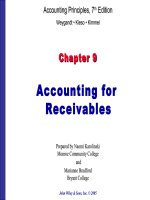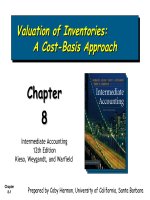Intermediate accounting 12th edition kieso warfield chapter 09
Bạn đang xem bản rút gọn của tài liệu. Xem và tải ngay bản đầy đủ của tài liệu tại đây (389.83 KB, 37 trang )
Inventories:
Inventories: Additional
Additional
Valuation
Valuation Issues
Issues
Chapter
9
Intermediate Accounting
12th Edition
Kieso, Weygandt, and Warfield
Chapter
9-1
Prepared by Coby Harmon, University of California, Santa Barbara
Learning
Learning Objectives
Objectives
1.
Describe and apply the lower-of-cost-or-market rule.
2.
Explain when companies value inventories at net realizable
value.
3.
Explain when companies use the relative sales value method
to value inventories.
4.
Discuss accounting issues related to purchase commitments.
5.
Determine ending inventory by applying the gross profit
method.
6.
Determine ending inventory by applying the retail inventory
method.
7.
Explain how to report and analyze inventory.
Chapter
9-2
Inventories:
Inventories: Additional
Additional Valuation
Valuation Issues
Issues
Lower-ofCost-orMarket
Ceiling and
floor
How LCM
works
Application of
LCM
“Market”
Evaluation of
rule
Chapter
9-3
Valuation
Bases
Net realizable
value
Relative sales
value
Purchase
commitments
Gross Profit
Method
Gross profit
percentage
Evaluation of
method
Retail
Inventory
Method
Concepts
Conventional
method
Special items
Evaluation of
method
Presentation
and Analysis
Presentation
Analysis
Lower-of-Cost-or-Market
Lower-of-Cost-or-Market
LCM
A company abandons the historical cost principle when
the future utility (revenue-producing ability) of the
asset drops below its original cost.
Market = Replacement Cost
Lower of Cost or Replacement Cost
Loss should be recorded when loss occurs, not in the
period of sale.
Chapter
9-4
LO 1 Describe and apply the lower-of-cost-or-market rule.
Lower-of-Cost-or-Market
Lower-of-Cost-or-Market
Ceiling and Floor
Why use Replacement Cost (RC) for Market?
Decline in the RC usually = decline in selling price.
RC allows a consistent rate of gross profit.
If reduction in RC fails to indicate reduction in utility,
then two additional valuation limitations are used:
Chapter
9-5
Ceiling - net realizable value and
Floor - net realizable value less a normal profit margin.
LO 1 Describe and apply the lower-of-cost-or-market rule.
Lower-of-Cost-or-Market
Lower-of-Cost-or-Market
What is the rationale for the
Ceiling and Floor limitations?
Illustration 9-3
Cost
Cost
Market
Market
GAAP
GAAP
LCM
LCM
Chapter
9-6
Ceiling = NRV
Not
>
Replacement
Cost
Not
<
Floor =
NRV less Normal
Profit Margin
LO 1 Describe and apply the lower-of-cost-or-market rule.
Lower-of-Cost-or-Market
Lower-of-Cost-or-Market
Rationale for Limitations
Ceiling – prevents overstatement of the value of
obsolete, damaged, or shopworn inventories.
Floor – deters understatement of inventory and
overstatement of the loss in the current period.
Chapter
9-7
LO 1 Describe and apply the lower-of-cost-or-market rule.
Lower-of-Cost-or-Market
Lower-of-Cost-or-Market
How LCM Works (Individual Items)
Illustration 9-5
Chapter
9-8
LO 1 Describe and apply the lower-of-cost-or-market rule.
Lower-of-Cost-or-Market
Lower-of-Cost-or-Market
Methods of Applying LCM
Illustration 9-6
Chapter
9-9
LO 1 Describe and apply the lower-of-cost-or-market rule.
Lower-of-Cost-or-Market
Lower-of-Cost-or-Market
Recording LCM (data from Illus. 9-5 and 9-6)
Ending inventory (cost)
415,000
Ending inventory (LCM)
350,000
Adjustment to LCM
Loss on inventory
Allowance
Allowance
65,000
Method
Allowance on inventory
Method
65,000
Direct
Direct
Method
Method
Chapter
9-10
Cost of goods sold
$
$
65,000
65,000
Inventory
65,000
LO 1 Describe and apply the lower-of-cost-or-market rule.
Lower-of-Cost-or-Market
Lower-of-Cost-or-Market
Balance Sheet Presentation
Chapter
9-11
LO 1 Describe and apply the lower-of-cost-or-market rule.
Lower-of-Cost-or-Market
Lower-of-Cost-or-Market
Income Statement Presentation
Sales
Allowance
$
Cost of goods sold
300,000
Direct
$
300,000
120,000
185,000
180,000
115,000
Selling
45,000
45,000
General and administrative
20,000
20,000
Total operating expenses
65,000
65,000
65,000
-
Gross profit
Operating expenses:
Other revenue and expense:
Loss on inventory
Interest income
5,000
Total other
5,000
(60,000)
5,000
Income from operations
55,000
55,000
Income tax expense
16,500
16,500
Net income
Chapter
9-12
$
38,500
$
38,500
LO 1 Describe and apply the lower-of-cost-or-market rule.
Lower-of-Cost-or-Market
Lower-of-Cost-or-Market
P9-1 Grant Wood Company manufactures desks. The company
attempts to obtain a 20% gross margin on selling price. At
December 31, 2008, the following finished desks appear in the
company’s inventory.
Finished Desks
Inventory cost
Est. cost to manufacture
Commissions and disposal costs
Catalog selling price
A
$ 470
460
45
500
B
$ 450
440
60
540
C
$ 830
610
90
900
D
$ 960
1,000
130
1,200
Instructions:
At what amount should the desks appear in the company’s December 31,
2008, inventory, assuming that the company has adopted a lower-of-cost-ormarket approach for valuation of inventories on an individual-item basis?
Chapter
9-13
LO 1 Describe and apply the lower-of-cost-or-market rule.
Lower-of-Cost-or-Market
Lower-of-Cost-or-Market
Finished Desks
Inventory cost
Est. cost to manufacture
Commissions and disposal costs
Catalog selling price
Cost
Cost == 470
470
A
$ 470
460
45
500
Market
Market == 455
455
Ceiling = 455
(500
(500 –– 45)
45)
Not
>
Replacement
Cost = 460
Not
<
Floor = 355
LCM
LCM == 455
455
Chapter
9-14
(455-(500
(455-(500 xx 20%))
20%))
LO 1 Describe and apply the lower-of-cost-or-market rule.
Lower-of-Cost-or-Market
Lower-of-Cost-or-Market
Finished Desks
Inventory cost
Est. cost to manufacture
Commissions and disposal costs
Catalog selling price
Cost
Cost == 450
450
B
$ 450
440
60
540
Market
Market == 440
440
Ceiling = 480
(540
(540 –– 60)
60)
Not
>
Replacement
Cost = 440
Not
<
Floor = 372
LCM
LCM == 440
440
Chapter
9-15
(480-(540
(480-(540 xx 20%))
20%))
LO 1 Describe and apply the lower-of-cost-or-market rule.
Lower-of-Cost-or-Market
Lower-of-Cost-or-Market
Finished Desks
Inventory cost
Est. cost to manufacture
Commissions and disposal costs
Catalog selling price
Cost
Cost == 830
830
C
$ 830
610
90
900
Market
Market == 630
630
Ceiling = 810
(900
(900 –– 90)
90)
Not
>
Replacement
Cost = 610
Not
<
Floor = 630
LCM
LCM == 630
630
Chapter
9-16
(810-(900
(810-(900 xx 20%))
20%))
LO 1 Describe and apply the lower-of-cost-or-market rule.
Lower-of-Cost-or-Market
Lower-of-Cost-or-Market
Finished Desks
Inventory cost
Est. cost to manufacture
Commissions and disposal costs
Catalog selling price
Cost
Cost == 960
960
D
$ 960
1,000
130
1,200
Ceiling = 1,070
(1,200
(1,200 –– 130)
130)
Not
>
Replacement
Cost = 1,000
Market
Market == 1,000
1,000
Not
<
Floor = 830
LCM
LCM == 960
960
Chapter
9-17
(1,070-(1,200
(1,070-(1,200 xx 20%))
20%))
LO 1 Describe and apply the lower-of-cost-or-market rule.
Lower-of-Cost-or-Market
Lower-of-Cost-or-Market
Evaluation of LCM Rule
Some Deficiencies:
Expense recorded when loss in utility occurs. Profit on
sale recognized at the point of sale.
Inventory valued at cost in one year and at market in the
next year.
Net income in year of loss is lower. Net income in
subsequent period may be higher than normal if expected
reductions in sales price do not materialize.
LCM uses a “normal profit” in determining inventory
values, which is a subjective measure.
Chapter
9-18
LO 1 Describe and apply the lower-of-cost-or-market rule.
Valuation
Valuation Bases
Bases
Net Realizable Value
Permitted by GAAP under the following conditions:
(1) a controlled market with a quoted price applicable to
all quantities, and
(2) no significant costs of disposal (rare metals and
agricultural products)
or
(3) too difficult to obtain cost figures (meatpacking)
Chapter
9-19
LO 2 Explain when companies value inventories at net realizable value.
Valuation
Valuation Bases
Bases
Relative Sales Value
Used when buying varying units in a single lump-sum purchase.
E9-7 (Relative Sales Value Method) Phil Collins Realty Corporation
purchased a tract of unimproved land for $55,000. This land was improved
and subdivided into building lots at an additional cost of $34,460. These
building lots were all of the same size but owing to differences in location
were offered for sale at different prices as follows. Operating expenses
allocated to this project total $18,200.
Chapter
9-20
Group
No. of
Lots
1
9
2
3
Price
per Lot
$
Lots Unsold
at Year-End
3,000
5
15
4,000
7
17
2,400
2
Instructions: Calculate
the net income realized
on this operation to
date.
LO 3 Explain when companies use the relative
sales value method to value inventories.
Valuation
Valuation Bases
Bases
E9-7 (Relative Sales Value Method - Solution)
Group
1
No. of
Price
Selling
Lots x per Lot = Price
9
$ 3,000
$ 27,000
Relative
Sales Price
Total
Cost
Cost = Allocated
x
$27,000/127,800
$ 89,460
$ 18,900
Cost
Per Lot
$ 2,100
2
15
4,000
60,000
60,000/127,800
89,460
42,000
2,800
3
17
2,400
40,800
40,000/127,800
89,460
28,560
1,680
$ 127,800
Group
1
Lots
Price
Total
Sold x per Lot = Sales
4
$ 3,000
$ 12,000
$ 89,460
Cost
Per Lot
Total Cost
of Goods
$ 2,100
$ 8,400
Calculation of Net Income
Sales
$ 80,000
Cost of good sold
56,000
2
8
4,000
32,000
2,800
22,400
Gross profit
24,000
3
15
2,400
36,000
1,680
25,200
Expenses
18,200
$ 80,000
Chapter
9-21
$ 56,000
Net income
$ 5,800
LO 3 Explain when companies use the relative
sales value method to value inventories.
Valuation
Valuation Bases
Bases
Purchase Commitments
Generally seller retains title to the merchandise.
Buyer recognizes no asset or liability.
If material, the buyer should disclose contract details in
footnote.
If the contract price is greater than the market price,
and the buyer expects that losses will occur when the
purchase is effected, the buyer should recognize losses
in the period during which such declines in market prices
take place.
Chapter
9-22
LO 4 Discuss accounting issues related to purchase commitments.
Gross
Gross Profit
Profit Method
Method
Substitute Measure to Approximate Inventory
Relies on Three Assumptions:
(1) Beginning inventory plus purchases equal total goods to
be accounted for.
(2) Goods not sold must be on hand.
(3) The sales, reduced to cost, deducted from the sum of
the opening inventory plus purchases, equal ending
inventory.
Chapter
9-23
LO 5 Determine ending inventory by applying the gross profit method.
Gross
Gross Profit
Profit Method
Method
E9-12 (Gross Profit Method) Mark Price Company uses the
gross profit method to estimate inventory for monthly
reporting purposes. Presented below is information for the
month of May.
Instructions:
Inventory, May 1
Purchases (gross)
Freight-in
Sales
Sales returns
Purchase discounts
$
160,000
640,000
30,000
1,000,000
70,000
12,000
(a) Compute the estimated inventory at May 31, assuming that the gross
profit is 30% of sales.
(b) Compute the estimated inventory at May 31, assuming that the gross
profit is 30% of cost.
Chapter
9-24
LO 5 Determine ending inventory by applying the gross profit method.
Gross
Gross Profit
Profit Method
Method
E9-12 (Gross Profit Method - Solution)
(a) Compute the estimated inventory assuming gross profit is 30% of sales.
(a) Inventory, May 1 (at cost)
$ 160,000
Purchases (gross) (at cost)
640,000
Purchase discounts
(12,000)
Freight-in
30,000
Goods available (at cost)
Sales (at selling price)
818,000
$ 1,000,000
Sales returns (at selling price)
(70,000)
Net sales (at selling price)
930,000
Less gross profit (30% of $930,000)
279,000
Sales (at cost)
Approximate inventory, May 31 (at cost)
Chapter
9-25
651,000
$ 167,000
LO 5 Determine ending inventory by applying the gross profit method.









